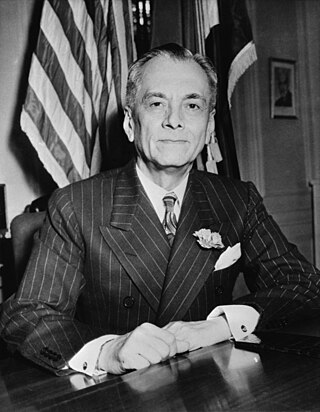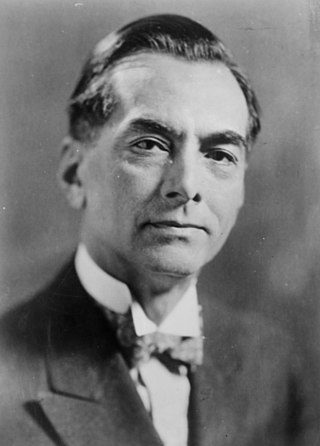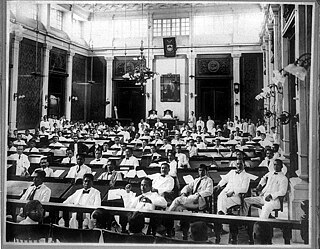
The Knesset is the unicameral legislature of Israel. As the supreme state body, the Knesset is sovereign and thus, with the exception of checks and balances from the courts and local governments, has total control over the entirety of the Israeli government.

The Commonwealth of the Philippines was an unincorporated territory and commonwealth of the United States that existed from 1935 to 1946. It was established following the Tydings–McDuffie Act to replace the Insular Government of the Philippine Islands and was designed as a transitional administration in preparation for full Philippine independence. Its foreign affairs remained managed by the United States.

Manuel Luis Quezon y Molina, also known by his initials MLQ, was a Filipino lawyer, statesman, soldier, and politician who was president of the Commonwealth of the Philippines from 1935 until his death in 1944. He was the first Filipino to head a government of the entire Philippines and is considered the second president of the Philippines after Emilio Aguinaldo (1899–1901), whom Quezon defeated in the 1935 presidential election.

Sergio Osmeña Sr. was a Filipino lawyer and politician who served as the fourth president of the Philippines from 1944 to 1946. He was vice president under Manuel L. Quezon. Upon Quezon's sudden death in 1944, Osmeña succeeded him at age 65, becoming the oldest person to assume the Philippine presidency until Rodrigo Duterte took office in 2016 at age 71. A founder of the Nacionalista Party, Osmeña was also the first Visayan to become president.

Claro Mayo Recto Jr. was a Filipino politician, statesman, lawyer, jurist, author, writer, columnist, and poet. Perhaps best known as the president of the 1934 Constitutional Convention and the Father of the 1935 Philippine Constitution, he is remembered as a fierce opponent of U.S. "neocolonialism" in Asia and for his staunch nationalist leadership throughout his career.
An electoral wipeout occurs when a major party receives far fewer votes or seats in a legislature than their position justifies. It is the opposite of a landslide victory; the two frequently go hand in hand.
Party switching is any change in political party affiliation of a partisan public figure, usually one currently holding elected office.

The Philippine Assembly was the lower house of the Philippine Legislature from 1907 to 1916, when it was renamed the House of Representatives of the Philippines. The Philippine Assembly was the first national legislative body fully chosen by elections.

The 1935 Philippine presidential and vice presidential elections were held on September 16, 1935. This was the first election since the enactment of the Tydings–McDuffie Act, a law that paved the way for a transitory government, as well as the first nationwide at-large election ever held in the Philippines.

Eva Estrada Kalaw was a Filipina politician who served as a senator in the Senate of the Philippines from 1965 to 1972 during the presidency of Ferdinand Marcos. She was one of the key opposition figures against Marcos' 20-year authoritarian rule and was instrumental in his downfall during the People Power Revolution. As a senator, she wrote several laws relating to education in the Philippines, such as the salary standardization for public school personnel, the Magna Carta for Private Schools, the Magna Carta for Students, and an act to institute a charter for Barrio High Schools. She was also among the Liberal Party candidates injured during the Plaza Miranda bombing on August 21, 1971.

The National Assembly of the Philippines refers to the legislature of the Commonwealth of the Philippines from 1935 to 1941, and of the Second Philippine Republic during the Japanese occupation. The National Assembly of the Commonwealth was created under the 1935 Constitution, which served as the Philippines' fundamental law to prepare it for its independence from the United States of America.
This list of presidential elections in the Philippines includes election results of both presidential and vice presidential elections since 1899 with the candidates' political party and their corresponding percentage.

The Philippine Legislature was the legislature of the Philippines from 1907 to 1935, during the American colonial period, and predecessor of the current Congress of the Philippines. It was bicameral and the legislative branch of the Insular Government.

A senatorial election was held in the Philippines on November 13, 1951. The election was known as a midterm election as the date when elected candidates take office falls halfway through President Elpidio Quirino's four-year term.

The First Congress of the Commonwealth of the Philippines, also known as the Postwar Congress, and the Liberation Congress, refers to the meeting of the bicameral legislature composed of the Senate and House of Representatives, from 1945 to 1946. The meeting only convened after the reestablishment of the Commonwealth of the Philippines in 1945 when President Sergio Osmeña called it to hold five special sessions. Osmeña had replaced Manuel L. Quezon as president after the former died in exile in the United States in 1944.

Jose Bayani "Pepito" Hidalgo Laurel Jr., also known as Jose B. Laurel Jr., was a Filipino politician who was elected twice as speaker of the House of Representatives of the Philippines. A stalwart of the Nacionalista Party, he was the party's candidate for the country's vice president in the 1957 elections.
Elections for the members of the House of Representatives were held on June 6, 1922, pursuant to the Philippine Organic Act of 1902, which prescribed holding elections every three years. The ruling Nacionalista Party was split into the Colectivista and the Unipersonalista factions. If combined, both blocs formed the largest party grouping in the House, with 64 of the 93 members. The Democrata Party emerged as the strongest opposition party since then Progresistas of the 1910s, winning 25 seats.
The Progresista Party was a political party in the Philippines during the early 20th century. Formed in 1900 as the Federalist Party, the party originally had the Philippines becoming a U.S. state as one of its original platforms, which was later rescinded.
The Victorian Labor Party, officially known as the Australian Labor Party and commonly referred to simply as Victorian Labor, is the Victorian state branch of the Australian Labor Party (ALP). The branch is currently the ruling parting in the state of Victoria and is led by Jacinta Allan, who has served concurrently as premier of Victoria since 2023.
The Democrata Party, also known as Partido Democrata Nacional was a political party in early 20th century Philippines, when the Philippines was an insular territory of the United States. It functioned as an opposition party against the ruling Nacionalista Party.














